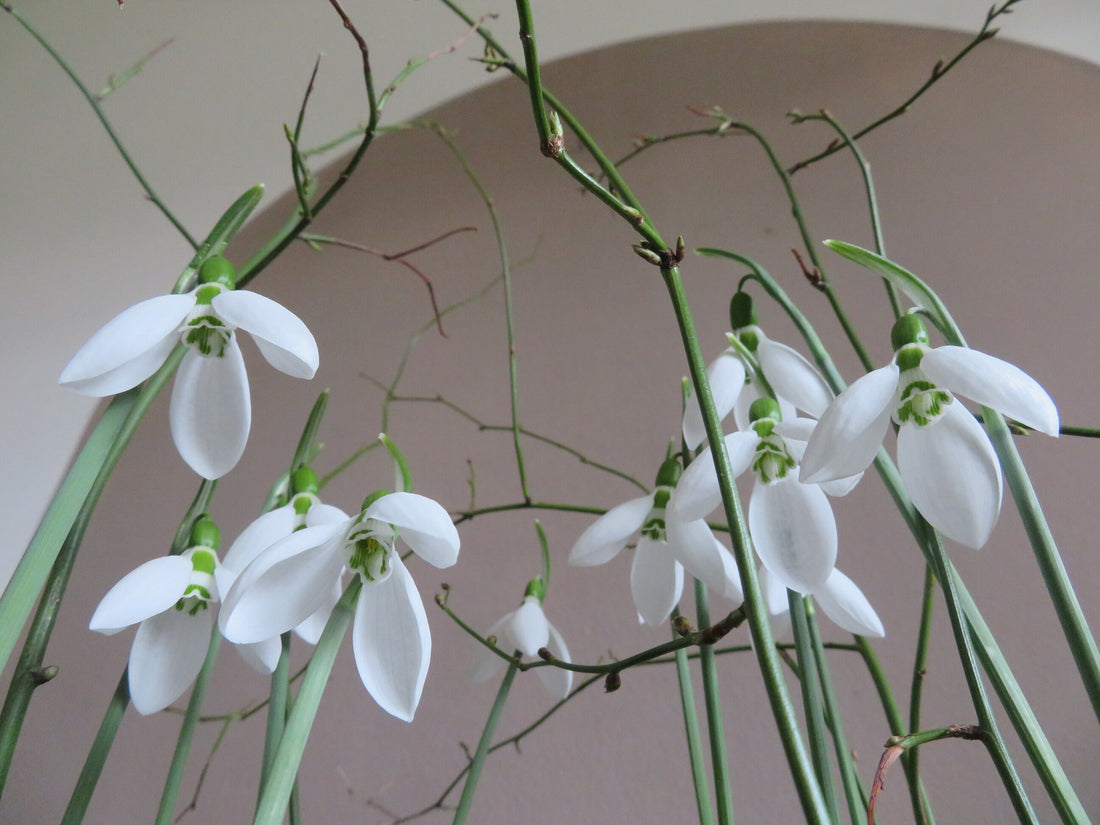I used to think that Cherry Blossoms and Peach Blossoms were the only ones signaling the arrival of spring. Only when I moved to live in Serbia did I learn about a type of flower that signals spring even before it fully awakens. That's the Snowdrop flower.
(I'm using hibicus braches to arrange parallel in a crystal bowl)
For months, the cold winter seemed to linger on. There were snow showers that seemed to wrap the entire countryside in a blanket, with the gloomy sky and earth devoid of any signs of life. But as I noticed the faint image of snowflakes and the white buds peeking through the soil, breaking through the snow to form small clusters nestled under the bushes, I knew that the weather was gradually warming up, and it was also the time when winter was preparing to bid farewell, making way for the fresh spring.
(Ivy leaves are used to create interesting movement for the design)
The name Snowdrop evokes images of delicate flowers emerging from a blanket of snow, and indeed, these flowers are aptly named for their living conditions and appearance. Snowdrops are scientifically known as Galanthus, originating from the Greek word meaning "milk-white flower" because their three petals are white and pure. Snowdrops originated from Europe and the Middle East. This type of flower was first mentioned in tales stories from ancient Greek and Roman mythology. The tale tells of how Snowdrops appeared in an interesting way, with a story about Persephone, the goddess of spring, who transformed a group of beautiful goddesses into Snowdrop flowers in the snowy forest to signal that warm spring days were approaching.
(a DIY yarn hat is useful to create the cover for the crystal bowl)
While woody plants remain dormant in the ground, Snowdrops, a soft-stemmed flower (soft as garlic leaves), thrive in harsh weather conditions. They adapt well to temperate climates and are often found in deciduous forests, meadows, or cool gardens. These flowers can adapt to different environments, prefer shade, and moist soil. They can also tolerate various types of soil, from sand to clay, making them one of the easiest plants to grow on Earth and widely cultivated in cold-climate gardens.
Because they prefer cool climates, when caring for cut flowers, we also create an environment similar to their natural habitat to keep them fresh for as long as possible.
(A closed up shot)
As for my experience growing Snowdrops, they don't need much fertilizer, just fallen leaves or a layer of straw around the base of the plant to retain moisture and prevent weeds from growing. So, for the past three years, I've had Snowdrops in my garden every year. I hope to separate them after this year to plant them all over the garden.
This year, the weather is warmer, so I cut a few Snowdrops and put them in a crystal bowl without using foam. I used short hibicus branches and wrapped them tightly with leaves to handle the technical part of making the flowers stand gracefully. Along with a few branches of Japanese quince that are sprouting. I hope that in the early days of the year, these pure, white Snowdrop flowers will bring luck and a good start to 2024.

(Me and my first arrangement of 2024)
I think this type of flower reminds us not to expect anything to come easy, but always carry within us the spirit to overcome challenges. Also, in any dark, gloomy period of life, we should not lose hope for a brighter tomorrow! This is indeed a flower that I will always tell as a source of inspiration that everyone should learn from. If you have ever grown or arranged Snowdrop flowers, what do you think of their delicate beauty? Take a moment to reflect on the deeper meanings they bring.
Happy Tết 2024!











